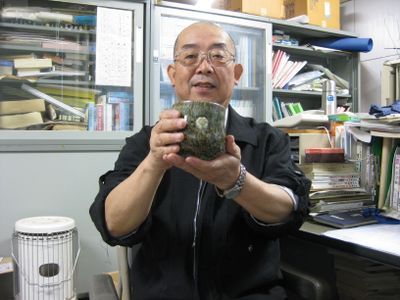
As you may know, Japan has lower per capita carbon emissions than any Western European country. For that reason, I asked my friend, Sean Saskamoto, who recently moved to Japan and who blogs at I’d Rather Be In Japan, to check in with us every so often. I thought we might be able to learn a little something about “happier planet, happlier people” lifestyles from Sean’s experience there.
Here is Sean’s latest dispatch:
Kawagishi-sensei is a Zen Buddhist monk, and he’s a teacher at the high school where I work. He teaches calligraphy, which is a traditional art in Japan. Like high schools in America, there are many clubs that students here can join. In the calligraphy club, students practice the art of painting Japanese Kanji, the Chinese characters that make up part of the written language. Painting calligraphy is an old tradition in Japan, and the characters look lovely, even to my untrained eye.
Kawagishi-sensei has been teaching calligraphy for over 30 years. My Japanese isn’t good enough to speak much with him, but a couple of times a week we try to chat. I noticed that every day he drinks his tea in a special teacup on his desk. It’s a beautiful ceramic cup. The rich, textured colors shine in the light, and I assumed it must be new because it’s so polished.
When I asked him about it, he told me that he’d bought it with his first paycheck as a teacher, thirty-five years ago. It was made in a famous Japanese style called Aritayaki. This cup of his has seen him through three and a half decades of his life. Every day he uses it, and it’s still a gorgeous cup.
What struck me was how much this cup must mean to him by now. It also seemed very kind to the environment to use just one cup in all that time. I know that if you took all the cups I’ve used over the past thirty years, they would probably need their own landfill. How many paper cups, Styrofoam coffees, coke bottles, water bottles…how much glass and plastic have I used and thrown away in the course of my days over the years? Too many to be sure.
Apart from the simplicity of using one cup is the fact that it’s made of clay. It was dug from the earth, molded by hand, glazed and fired in a kiln. It made me think that consumption itself isn’t necessarily bad. There are ways to own things that can be fun, and even meaningful, and also friendly to the environment. What if everything I owned was acquired to celebrate an occasion, and lasted a lifetime?